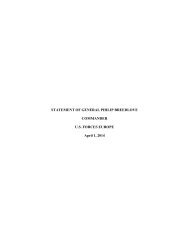FULLTEXT01
FULLTEXT01
FULLTEXT01
Create successful ePaper yourself
Turn your PDF publications into a flip-book with our unique Google optimized e-Paper software.
TACTICAL THOUGHT<br />
2014 September 29 th<br />
A rather consistent way of thinking exists with a self-image of field or troop officer,<br />
thinking tactics as a combination of theory and practice, and with a basic offensive<br />
mind-set. Skills and knowledge in Regular Warfare for national defence needs are<br />
higher prioritized than skills in Irregular Warfare for multinational operations. Focus is<br />
on troops rather than technical aspects, with an ambition to lead and develop tactics for<br />
larger units (battalion structures rather than specialized company formations).<br />
The officers’ general reflections on tactics in Irregular Warfare 192 can be characterized<br />
by expressions mostly regarding conceptual aspects, including capability and functional<br />
area aspects, for example, Intelligence. Broader aspects such as military and civilian<br />
relations, education and training, leadership and mind-set are addressed only on a few<br />
occasions. Even if many of the articulations correspond to general current COIN<br />
standards, views still exist with a more Regular Warfare mind-set. A major aspect in<br />
thinking relates to new or other demands in command and functional thinking, for<br />
example, Intelligence, Psychological Operations and Electronic Warfare. A minor<br />
number of officers emphasized Regular Warfare capabilities.<br />
As for war fighting capabilities, moral and conceptual factors (or combined) are in<br />
focus, as opposed to physical factors. A common view of tactics in Irregular Warfare<br />
and Counterinsurgency is a focus on Guerrilla Warfare, in contrast to lower violence<br />
areas such as subversion and terrorism. Regarding conceptual views, a unified focus on<br />
basic battalion structures with additional special functions, capable of operating in task<br />
group structures is evident. Tactics in Irregular Warfare is viewed to have a low priority<br />
in the Swedish Armed Forces. Quite a common view however, is that development of<br />
tactics for Irregular Warfare is needed and important.<br />
The Main result; the model of the Swedish space of statements of thought on tactics in<br />
Irregular Warfare consists of a two-by-two generic model of tactical types. 193 This<br />
model provides an inter-subjective constructed structure of the space of statements. The<br />
tactical types are labelled and broadly explained as follows: 1) Regular Warfare; ranger<br />
tactics with focus on military tasks, smaller and larger units and reconnaissance: 2)<br />
Regular Warfare; mechanized tactics with focus on military tasks, larger units, and<br />
combat: 3) Irregular/Hybrid Warfare: infantry tactics focused on mixed military and<br />
civilian tasks, smaller and larger units, reconnaissance and combat: and finally, 4)<br />
Irregular/Hybrid Warfare: mechanized tactics focused on military and civilian tasks,<br />
larger units and combat. These tactical types are suggested as the content of the space of<br />
statements, mainly constructed with two perspectives; contextual and conceptual. The<br />
investigated sample distributes quite equally over the types 2, 3 and 4. A certain weight<br />
can be noted for type 1.<br />
Sociological structures of background factors positioned in the space of statements are<br />
possible to identify. 194 . Unit affiliation (regimental culture and traditions) and Unit<br />
background distribute most clearly. Unit affiliation and background show correlation<br />
regarding ranger and infantry affiliation, background and tactical thinking.<br />
192 pp. 62-63. The result regarding general reflection on tactics in Irregular Warfare.<br />
193 p. 75. The result in the form of a model of the distribution of standpoints.<br />
194 pp. 78-84. Result of background factor structures in the space of statements.<br />
101





